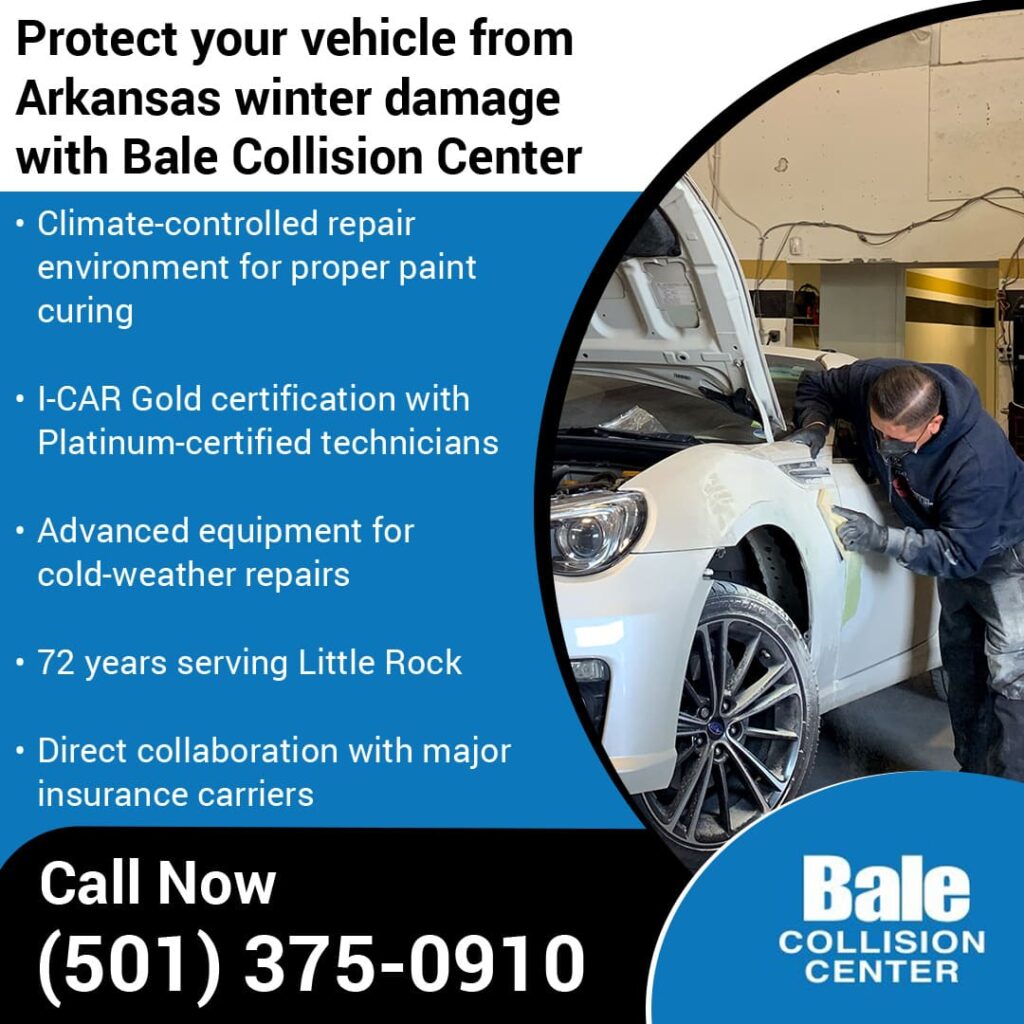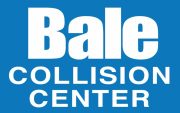Winter months in Arkansas present distinct challenges for vehicle owners throughout Little Rock and the surrounding areas. Unlike northern states, where consistent cold dominates the season, Arkansas experiences volatile weather patterns that alternate between freezing temperatures and mild conditions. This variability creates conditions particularly harmful to vehicle exteriors.
Ice storms rank among the most destructive winter weather events affecting Arkansas vehicles. These conditions damaged thousands of vehicles across multiple counties. Road treatments applied during winter weather introduce another layer of complexity. De-icing chemicals accelerate corrosion on exposed metal surfaces.
At Bale Collision Center (Downtown), we address these winter-specific challenges with advanced equipment and certified expertise. Our I-CAR Gold certification demonstrates technical proficiency in managing complex repair processes when harsh weather conditions create obstacles for standard procedures. With 72 years of experience, we deliver specialized Downtown Little Rock auto body services that produce lasting results through proper techniques and equipment.

Arkansas Winter Weather Patterns and Vehicle Impact
Arkansas experiences distinct winter weather that differs from simple cold temperatures. The state faces ice storms, freezing rain, and temperature fluctuations that create unique vehicle damage patterns.
Ice Storm Frequency in Central Arkansas
Ice storms deposit between one-half and three-quarters of an inch of ice on vehicles during major weather events. These events coat vehicles in thick ice layers that damage paint during removal and create dents from accumulated weight. Ice buildup on parked vehicles can persist for days when temperatures remain below freezing, extending exposure to potential damage.
Temperature Fluctuations and Material Stress
Little Rock winters combine freezing nights with warmer days. This pattern causes repeated expansion and contraction in paint and metal.
| Time of Day | Temperature | Material Response |
| Afternoon | 50°F | Paint and metal expand |
| Overnight | 30°F | Paint and metal contract |
The freeze-thaw cycle creates progressive damage. Water seeps into small paint chips and freezes overnight. Freezing causes the water to expand, widening the crack. When temperatures rise, the expanded crack remains. This allows more moisture entry during the next cycle.
Black ice forms when moisture on roads freezes into transparent layers. Bridges and overpasses freeze first because they lack ground insulation. Arkansas Department of Transportation reports multiple accidents during black ice conditions each winter, increasing repair demand.
Cold Temperature Effects on Auto Body Repair
Temperature directly affects how repair materials behave and cure. Paint, metal, and adhesives all require specific temperature ranges for proper application and bonding.
Paint Application and Curing in Cold Weather
Paint stops curing when temperatures drop below 55°F. This causes application failures and surface defects. Chemical reactions between paint components require warmth to proceed correctly. At 70°F, most automotive paints cure in approximately four hours. Below 55°F, curing slows dramatically or stops completely.
Fresh paint applied in cold conditions exhibits several failure modes:
- Cracking occurs when paint contracts faster than the underlying metal
- Flaking happens when paint doesn’t achieve proper adhesion
- Orange peel texture develops when solvents don’t evaporate correctly
Winter humidity combined with cold temperatures extends paint drying considerably. Standard drying times can double or triple in cold, humid conditions. Arkansas winters bring both factors simultaneously. Professional auto body shops maintain paint booth temperatures between 68°F and 77°F. They use dehumidification systems that remove excess moisture from booth air.
These controlled conditions allow proper chemical reactions between clearcoats and hardeners, producing durable finishes that withstand daily use. Vehicles need additional time at auto body shops during winter for proper curing rather than compromising quality.
Metal Brittleness During Dent Removal
Cold metal becomes rigid and prone to cracking during repair work. Technicians must heat metal panels before performing dent removal when temperatures drop below 50°F. This heating restores flexibility without making the metal too soft for proper shaping.
Gradual heating prevents thermal shock that can crack paint around repair areas. Panel heaters warm metal to working temperature over several minutes. Attempting dent removal on cold metal risks creating additional cracks in both metal and surrounding paint, turning simple repairs into complex projects requiring panel replacement.
Ice Storm and Road Salt Damage
Ice storms create multiple damage categories requiring different approaches. Understanding these damage types helps vehicle owners recognize when professional car body repairs become necessary.
Ice Accumulation and Removal Damage
Ice accumulation adds substantial weight to vehicle surfaces, potentially denting hoods, roofs, and trunk lids. Research by utility companies shows that half an inch of ice increases tree limb weight by 30 times. Similar weight increases affect vehicles during ice storms.
Scraping ice from vehicles causes extensive paint damage. Using ice scrapers, shovels, or other rigid tools to remove ice causes extensive paint damage. Cold temperatures make plastic trim pieces brittle, so they crack under scraping pressure. Deep scratches require professional paint correction through buffing, polishing, or refinishing.
Ice sheets that form on vehicle roofs become projectiles during highway driving. According to AAA, dislodged ice carries an impact force equivalent to bricks. This ice damages hoods, cracks windshields, and dents body panels, requiring both metal shaping and paint refinishing.
Salt and Moisture Corrosion
Road salt mixed with moisture creates corrosive solutions that attack paint and metal surfaces. Arkansas uses de-icing chemicals on major highways and bridges during winter freezes. Salt remains active on vehicle surfaces for days or weeks after application. When combined with Arkansas’s humidity, this creates persistent corrosion conditions.
Salt deposits concentrate in specific areas:
- Wheel wells
- Undercarriages
- Door seams
These areas trap moisture and salt residue. They remain hidden from casual inspection. Rust begins within days when bare metal contacts salt water. Small paint chips exposing metal show rust spots within one week during winter conditions. Once rust starts, it continues even in dry conditions. It spreads underneath intact paint and creates larger damaged areas.
Professional Paintwork During Cold Weather
Paintwork represents the most temperature-sensitive repair process. Success requires controlled environments and proper material handling at auto body shops.
Temperature-Controlled Booth Requirements
Professional paint booths maintain consistent 70°F temperatures and 50% humidity regardless of outdoor conditions. These systems heat incoming air, control airflow patterns, and manage moisture levels. Facilities without climate control cannot perform reliable paint work during Arkansas winters.
At Bale Collision Center, we use Blowtherm heated downdraft paint booth systems. These booths maintain precise temperature control while directing airflow from ceiling to floor. The BASF waterborne paint system used at our facility performs optimally in controlled temperature and humidity, producing factory-quality finishes.
Vehicles entering warm paint booths from cold outdoor storage require gradual warming to prevent thermal shock. When cold metal meets warm air suddenly, surface condensation forms. This moisture barrier prevents paint adhesion, causing bubbling, peeling, or texture defects. Professional body shops store vehicles in heated staging areas before painting to eliminate these risks.
Material Handling
Paint materials require storage at room temperature. Cold paint doesn’t spray correctly. It won’t cure properly even in heated booths. Paint viscosity changes with temperature. Cold paint becomes thick and difficult to atomize through spray equipment. This creates application problems:
- Runs
- Sags
- Poor coverage
Hardeners and activators also require proper temperature. Cold hardeners don’t mix thoroughly with paint, producing incomplete curing and soft finishes vulnerable to damage. Professional facilities store all paint materials in climate-controlled areas to maintain consistency.
Collision Damage from Winter Road Conditions
Ice and snow increase accident frequency during Arkansas winters. These collisions create specific damage patterns requiring thorough assessment.
Hidden Structural Damage
Minor winter collisions often hide serious structural damage beneath visible surface dents. Frame rails, suspension mounts, and crumple zones can sustain damage that doesn’t show in casual inspection. Professional car body repair shops use frame measuring equipment to identify these hidden problems.
At Bale Collision Center, we employ car-o-liner frame measuring systems that detect misalignment down to millimeter accuracy. This precision matters because even slight frame distortion affects vehicle handling, tire wear, and safety system function. Front-end collisions on icy roads commonly damage radiator supports, hood latches, and headlight mounting structures.
Safety System Impacts
Modern vehicles contain Advanced Driver Assistance Systems (ADAS) that help drivers avoid collisions. These systems require recalibration after car body repair work. Cameras and sensors mounted in bumpers, windshields, and mirrors need precise positioning.
Our shop uses VSSTA diagnostic and calibration equipment to verify proper ADAS function after repairs. This equipment tests forward collision warning, lane departure warning, and automatic emergency braking systems according to manufacturer specifications.
Immediate Repair Benefits
Delaying winter damage repairs creates progressive deterioration. Prompt professional service prevents minor damage from becoming major problems.
Rust Prevention and Spread
Bare metal exposed by paint chips begins rusting within 48 hours when contacted by salt-laden moisture. This timeline accelerates during Arkansas winters when salt treatments remain on roads for extended periods. Rust spreads underneath intact paint surrounding damage points, weakening paint adhesion across larger areas.
What started as a small chip requiring simple touch-up becomes a large area needing complete panel refinishing. The aggressive environment created by ice, salt, and freeze-thaw cycles causes damage to progress faster than in summer conditions. A few months of winter exposure create more deterioration than years of summer weather.
Vehicle Value Protection
Rust damage reduces vehicle resale value substantially. Buyers recognize rust as a sign of neglected maintenance and potential hidden problems. Professional repairs maintain vehicle appearance and value through quality auto body repair work and paint matching that restores the original appearance.
Professional Facility Requirements
Choosing certified auto body repairfacilities that are properly equipped makes the difference between successful repairs and winter failures. Equipment, training, and certification separate professional Downtown Little Rock auto body services from basic operations.
Climate Control and Equipment
Temperature-controlled facilities maintain proper conditions for all repair processes. Paint booth climate control provides the most critical advantage. Professional shops invest in equipment designed for cold-weather challenges:
- Panel heaters warm metal before dent removal, preventing brittleness problems
- Infrared curing lamps accelerate paint drying when winter humidity extends natural drying times
- Frame straightening equipment operates in heated facilities where metal behaves predictably
Certified Auto Body Repair Technicians
I-CAR Gold certification indicates shops maintain high training levels across their entire team. This certification requires documented training in current repair methods, proper equipment use, and understanding of environmental factors affecting repairs.
Bale Collision Center’s I-CAR Gold status reflects ongoing training commitment. Our technicians have I-CAR Platinum certification and understand how Arkansas winters affect repairs and take appropriate precautions for lasting results. ASE (Automotive Service Excellence) certification provides additional verification of technician knowledge and commitment to professional standards.

Expert Auto Body Repairs in Downtown Little Rock, Arkansas
Bale Collision Center has served the Little Rock community since 1952, building expertise in handling Arkansas-specific winter damage patterns. Our facility combines decades of local knowledge with modern repair technology and I-CAR Platinum-certified auto body repair technicians. We maintain specialized equipment designed to address cold-weather repair challenges, from heated work areas to advanced paint systems that function reliably regardless of outdoor temperatures.
OEM Repair Procedures
We follow Original Equipment Manufacturer specifications for every vehicle make and model. These procedures maintain factory safety standards and preserve warranty coverage. Modern vehicles use different materials, including aluminum panels, high-strength steel, and composite components. Each material requires specific repair techniques.
Frame straightening follows manufacturer specifications for attachment points, pull angles, and measurement tolerances. Our Car-o-liner equipment includes manufacturer-specific fixture databases for hundreds of vehicle models.
Insurance and Customer Service
We work with all major insurance carriers, handling claim documentation, communicating with adjusters, and managing paperwork from initial estimates through final payment. Pre-repair inspections identify all damage requiring attention. We document findings with photographs and detailed written descriptions, preventing disputes about repair scope. We provide repair updates twice weekly with progress photos, parts delivery status, and timeline adjustments when needed.
Contact Bale Collision Center
Schedule your winter damage assessment today. Contact Bale Collision Center at (501) 375-0910 or email bccdowntown@baleautomotive.com for a professional evaluation and learn more about our Downtown Little Rock auto body services.
